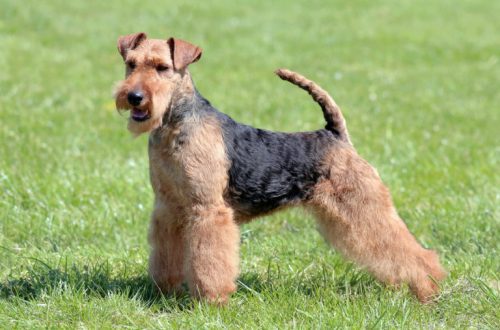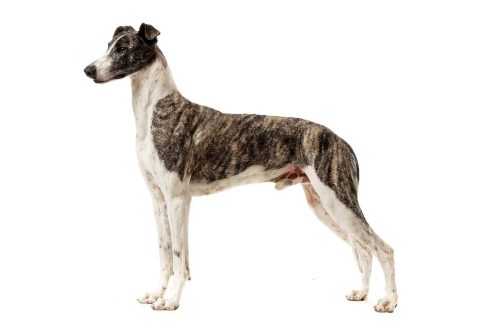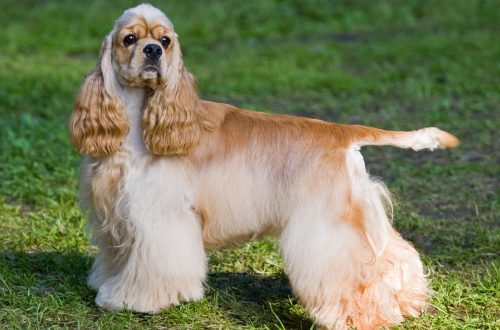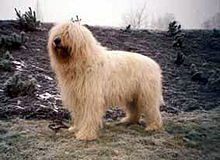
South Russian Ovcharka
South Russian Ovcharka Other names: Yuro , Yuzhak, South Russian Shepherd Dog
The South Russian Shepherd Dog is a breed of large dogs of white, fawn and gray colors, traditionally bred in the southern regions of Russia and Ukraine.
Contents
- Characteristics of South Russian Ovcharka
- Basic moments
- History of the breed South Russian Shepherd Dog
- Video: South Russian Shepherd Dog
- Breed standard South Russian Shepherd Dog
- The nature of the South Russian Shepherd Dog
- South Russian Ovcharka Education and training
- Maintenance and care
- Health and disease of South Russian Shepherd Dogs
- How to choose a puppy of South Russian Ovcharka
- South Russian Shepherd Price
Characteristics of South Russian Ovcharka
| Country of origin | Russia |
| The size | Large |
| Growth | 62-66 cm |
| Weight | 35–50 kg |
| Age | 11–13 years old |
| FCI breed group | Herding and cattle dogs other than Swiss cattle dogs |
Basic moments
- The South Russian Shepherd Dog is a rare, almost exclusive breed, the development of which has been negatively affected by commercial breeding that has been observed in recent years.
- From the wool of the southerner, excellent yarn is obtained, from which you can knit or knit beautiful things that have a healing effect.
- In the case of the YuRO, there is almost no differentiation in the breeding line, so the future service dog and companion dog have to be chosen within the same litter.
- One of the favorite activities of the South Russian Shepherd Dogs is digging holes, which, given the size of the representatives of the breed, are more like construction pits.
- Yuzhaks are not recommended for keeping as a first dog, as well as for people who do not have experience in training working shepherd dogs.
- You will have to take care of the hair of a show-class pet a lot and not without the help of groomers. Keep in mind that the fluffy “fur coats” of the YuRO quickly fall off, attract small debris and easily change color depending on the diet.
- Paradoxically, not being bullies in essence, South Russian Shepherd Dogs do not make good contacts with other dogs and are able to make friends with few of their fellow tribesmen.
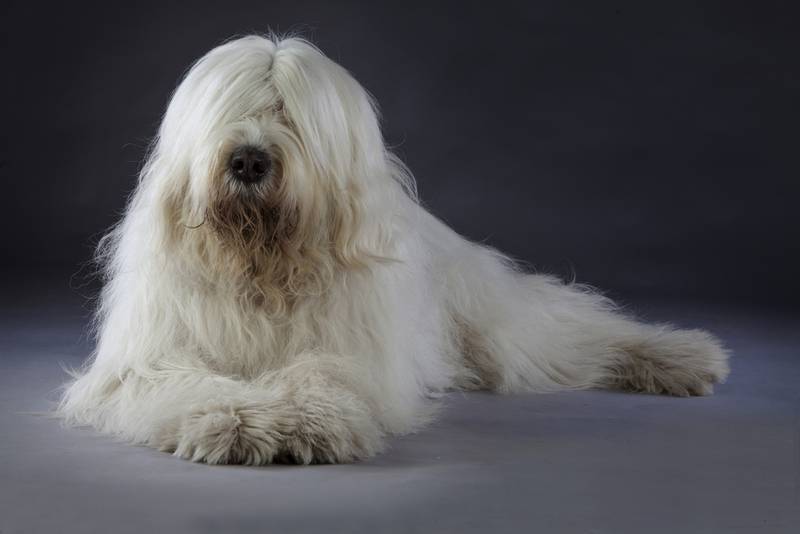
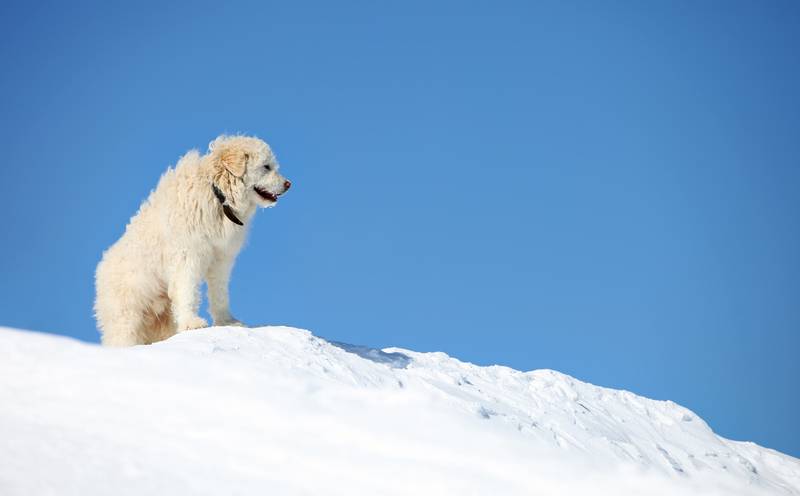
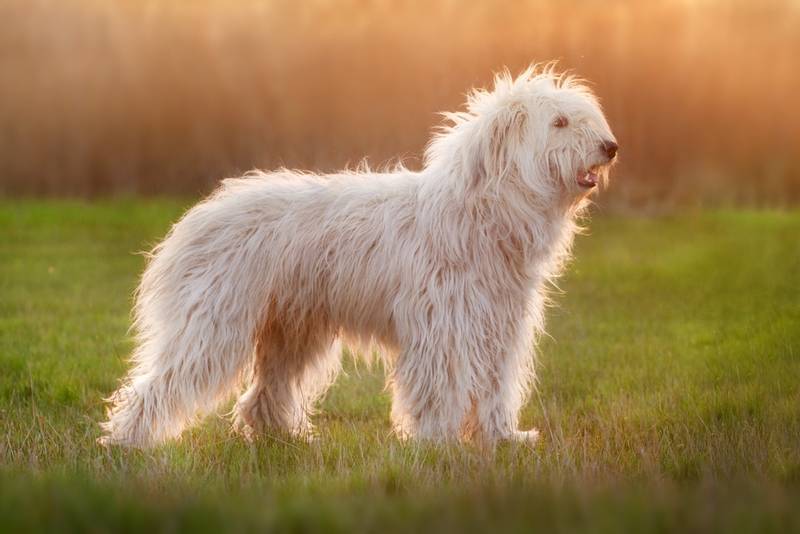
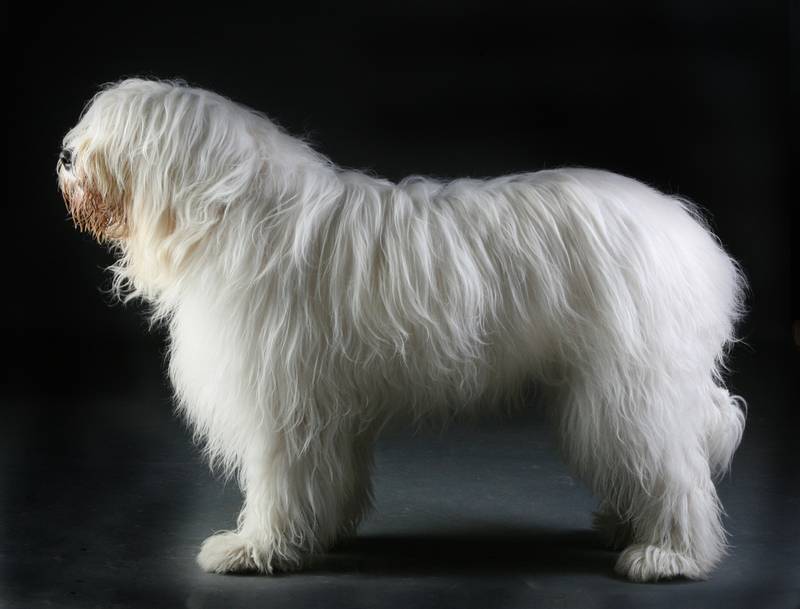
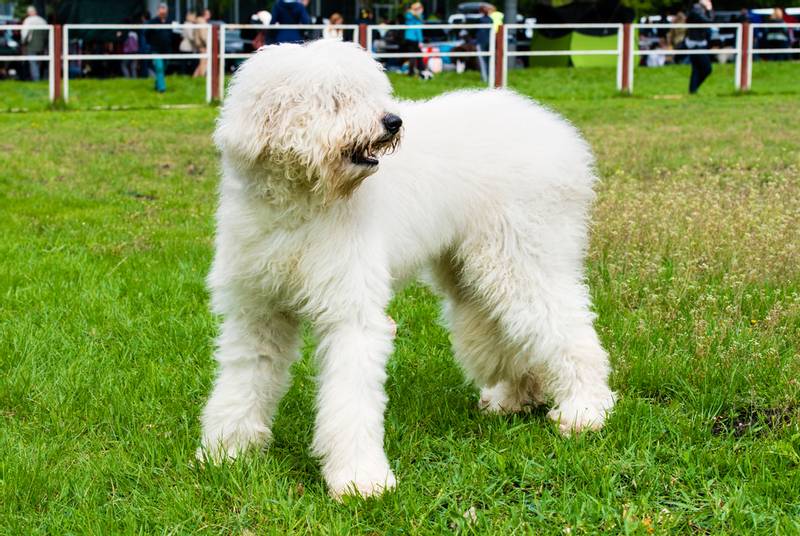
The South Russian Shepherd Dog is a shaggy hero who has established herself as a professional guardian of the master’s peace and well-being. Possessing a serious character and an innate suspicion of violators of territorial boundaries, the southerners never stir up conflicts from scratch. The only thing that will have to be taken into account when having a South Russian Shepherd Dog at home is the tendency of the breed to play ahead of the curve and think for the owner in critical situations.
History of the breed South Russian Shepherd Dog
There is a heated debate about the true roots of the southerners. Despite this, there is still no reliable data on which breed was at the origin of the origin of the Yuro clan. According to one version, the ancestors of the animals were Spanish mastiff-like dogs, which were brought to the southern regions of Russia to protect fine-fleeced sheep imported from the Iberian Peninsula.
The famous Russian cynologist Vsevolod Yazykov adhered to a different theory. In his own writings, the researcher relied on a historical document, according to which in 1808 Russia purchased 1,000 merinos from the Saxon kingdom. It turned out to be unrealistic to drive the sheep over such a long distance by the shepherds, so German shepherds were involved in the case. When the Merinos arrived at their destination, their four-legged watchmen also settled in Russian territories, mixing with local dogs and giving birth to a new breed.
In addition, the formation of the historical phenotype of the Yuzhaks was influenced by the decree of Nicholas I. In 1826, the emperor began to develop domestic sheep breeding, recruiting foreign farmers, whom he promised to free from all sorts of duties and taxes. As a result, shepherd dogs from other countries reached the southern provinces, taking European shepherd dogs on the road, which made their genetic contribution to the exterior of the South Russian shepherd dogs.
As for the factory breeding of Yuzhaks, it is attributed to the founder of the Kherson biosphere reserve “Askania-Nova” – Friedrich Falz-Fein. A well-known livestock specialist conducted breeding experiments and arranged offspring reviews, which made it possible to obtain dogs that were valuable in terms of work. In 1904, the Falz-Fein South Russian Shepherd Dogs were exhibited at the Paris exhibition, but the triumph of the breed did not last long.
After the revolution, the number of Yuzhaks in Russia declined sharply. It was their own dedication that helped the animals lose the war for the right to exist. YuRO bravely defended sheep herds from gangs of “white” and “red” marauders, which in the conditions of the civil war did not leave them a chance to live. Before the Great Patriotic War, the number of South Russian Shepherd Dogs increased slightly, but the Germans who occupied the Soviet territories did not like the defender dogs either, which led to the extermination of the breed.
By the 50s of the 20th century, there were no worthy southerners in the USSR, but the cynologists were obsessed with the desire to revive the unique white-haired dog. It was possible to give the South Russian Shepherd Dogs a second life by infusing the blood of “Caucasians” into its phenotype. As a result, Soviet breeders nevertheless acquired a valuable breed, although outwardly modern individuals differ from their relatives bred in Tsarist Russia.
Video: South Russian Shepherd Dog
Breed standard South Russian Shepherd Dog
Visually, the South Russian Shepherd Dog is easily confused with the Hungarian Komondor and even easier with the English Bobtail. By the way, the conspicuous sluggishness and bearish clumsiness of the breed are an optical illusion created by abundant shaggy hair. Under a pile of wavy hair and a cottony layer of undercoat, a completely athletic body is hidden, capable of showing miracles of agility and acrobatics. A vivid confirmation of this is the circus southerners, who perform the most difficult artistic tricks in one breath.
Anatomical differences between males and females are also noticeable. So, for example, “girls” have a more stretched body format. The difference in height between males and females is not so significant. The lower height limit for females is 62 cm, for males – 65 cm. Due to the stylish “mane” on the neck, the males look more adventurous than their four-legged companions, whose throat area is not so chic.
South Russian Ovcharka Head
The head of the South Russian Shepherd Dog is formed into an elongated wedge with relief cheekbones, tapering in the muzzle area. Mandatory proportions: head in length is approximately 40% of the height of the animal. Skull with flat forehead, protruding occipital bone (tubercle) and smoothed eyebrows. Muzzle with a flat back and a slightly noticeable stop.
Nose
Developed lobe of anthracite color. In South Russian shepherd dogs of fawn-white, as well as fawn color, in the hot season, the skin of the nose may fade, which is acceptable. However, even in these individuals, the edging of the lobe must have a rich black tone.
Teeth, jaws
The traditional set is 42 large white teeth with incisors lined up in one line. Permissible variations are double first premolars, broken incisors that do not distort the standard bite. The South Russian Shepherd Dog has very powerful grasping jaws, in the bow forming a scissor-like ratio of dentition.
South Russian Ovcharka Eyes
For the eyes of representatives of this breed, a wide, straight landing is typical. The eyes themselves are oval, medium-sized, with dense dry eyelids, bordered by a black stroke. The color of the iris is from light to dark brown, but dark tones are preferable.
Ears
Triangle ears are not very large, hanging type. The planting of the cartilage is high, the edge of the ear blade touches the cheekbones.
Neck
The oval neck of the South Russian Shepherd Dog is distinguished by a pronounced dryness of contours and muscularity.
South Russian Ovcharka Frame
The body of the South Russian Shepherd Dog is strong, but without a bias towards excessive pumping. The body is 10-12% longer than the height of the animal at the withers. The back in the lumbar zone forms a small arc, which in mature individuals (from 5 years old) can be smoothed out.
The bend of the withers is weakly marked, the back is elongated and wide. The lumbar region is convex, not prominent in length, springy. The croup of the dog is located 1-2 cm above the withers and is characterized by a slight slope and a decent width. The traditional features of the Souther chest are protrusion of the shoulder-scapular joints, an oval section, good width with flat ribs. The bottom of the chest is located at the level of the elbow joints, the stomach is slightly tucked up.
limbs
The legs of the South Russian shepherd dogs are of a muscular type, even, parallel to each other, and the hind limbs are set much wider than the front ones. The humerus and elongated shoulder blades form a 100° articulation angle. The dog’s elbows point back. Strong, dry-type wrists merge into strong, slightly elongated pasterns with a slight slope.
The massive dense hips of the southerner have the same length as the lower legs set at an angle. Knee joints are clearly drawn, hocks – with obvious angles, flattened shape. Metatarsus dryish, not very stretched, without dewclaws. For the paws of shepherd dogs, arching and oval outlines are required. There are no color restrictions on pads and claws. The animal moves in a balanced gallop or trot. The pace is measured and straight.
South Russian Ovcharka Tail
The tails of the southerners are quite thick, wrapped in a half ring or twisted into a hook. Length – on the same line with the hocks or slightly below their level. A pacified animal carries its tail lowered, an excited one raises it to the upper back, and the tip is even a little higher.
Wool
Mandatory requirements for the wool of the South Russian Shepherd Dog: the length of the awn is not less than 10 cm, a coarse wavy or broken structure, the presence of a thick long undercoat. By the way, about the undercoat: it tends to fall off, forming a warm protective sweatshirt. However, in the ring, individuals with a completely combed undercoat, like those with tangles, do not receive the highest score.
In purebred individuals, the hair is plentiful, of the same length on all parts of the body. On the head, long hair forms a “moustache”, a “beard” and a thick bang.
South Russian Ovcharka Color
South Russian Shepherd Dogs come in fawn, gray, yellowish white, solid white, and also white with fawn or gray spots. An important nuance: in spotted individuals, colored marks should be extremely lightened and have blurry outlines. Perhaps the presence of snow-white blazes (head and muzzle) in individuals of fawn and gray colors. In addition, white spots on the paws, sternum and end of the tail are acceptable for them.
Important: South Russian Shepherd puppies have brighter colors. Completely the formation of the tone of the coat ends in 1-2-year-old dogs.
Disqualifying defects of the breed
- Choleric temperament; cowardly, aggressive habits.
- Violation of the breed type.
- Square or round skull.
- Inversion of the eyelids, heterochromia. Green, blue, whitish iris.
- Lack of teeth other than M3 and P1.
- Coat – with curls, cord-like, short, lying on the legs and head.
- Color violations: brown, blue, tricolor and red.
- The presence of a mask on the muzzle and a saddle on the body.
- Lobe and lips with spots or in a pink tone.
- Amble.
- Curly or docked tail.
The nature of the South Russian Shepherd Dog
Representatives of the breed have a typical “shepherd” character, due to which they truly love and listen to only one family member. At the same time, fawning and every minute looking back at the actions of the owner – this is also not about the southerners. In critical situations, dogs are able to make a decision without languishing in anticipation of the command, and it can be difficult to stop their initiative at such moments. When acquiring a South Russian Shepherd, do not forget that you are bringing into the house a serious working dog with clearly manifested “Caucasian” genes. And this, firstly, is systematic training, and secondly, it is responsibility and the ability to build the right partnership with the ward, in which the owner is the eldest.
Yuro makes unsurpassed bodyguards and good watchmen. Representatives of the breed know how to repulse an enemy attack with a threatening growl and a disarming grip from birth. Especially southerners like to guard not property, but territory, therefore, to protect the plot and control over summer cottages, you cannot find the best pet. Dogs are extremely selective in choosing friends among relatives. For someone, the South Russian Shepherd patiently pulls off light pranks, condescendingly wagging his tail, but for someone he will never forgive a harmless attack. Accordingly, when taking a shaggy “blonde” to the dog playground, be mentally prepared for both a positive behavior model and a negative one – it is impossible to predict which “tail” the South Russian Shepherd will not like.
A lot of photos “walk” on the Internet, in which representatives of the breed have fun with children, ride babies on their backs and “wash” the language of young dirty ones. True, there is one caveat: all children from such pictures are members of the dog owner’s family, which automatically translates them into the inner circle of the animal. If you want YURO to endure unfamiliar children (not to be confused with the word “loved”), this quality will have to be brought up in her. But keep in mind that loyalty to other people’s children ends where the territory of the master’s possessions begins. If young lovers of free apples are in the habit of dropping into your garden, you can’t count on a dog’s condescending attitude towards them.
For your information: South Russian Shepherd Dogs do not attack the enemy directly. Usually the animal comes from the back and sides, biting the enemy from all sides. Among specialists, this technique is called “dance”.
A separate caste in the life of South Russian Shepherd Dogs is teenagers. The dog stubbornly does not want to see an adult in a teenager, but he will not be attributed to kids who need to get away with everything. Hence the constant conflicts with the younger generation and the struggle for spheres of influence, which should not be encouraged. As for cats and other representatives of the domestic fauna with which the dog shares the territory, by and large nothing threatens them. Sometimes, if the cat is older, he is able to crush the young southerner under him and climb to the top of the hierarchical pyramid. Bonuses, which at the same time receives a purr: the dog’s infinite respect and the ability to occasionally poke around in his food bowl without risking his own life.
South Russian Ovcharka Education and training
The South Russian Shepherd Dog does not need to be taught to guard and protect – it initially carries these skills in its genes. But it is simply necessary to correct habits and direct animal aggression in the right direction if you do not want to keep an evil and ill-mannered creature at home that does not recognize anyone’s authorities.
An obligatory stage in the life of the South Russian Shepherd Dog is socialization. If you do not plan to raise a monster from a puppy, from which the whole district flies away, be sure to introduce the animal to the realities of urban or rural life. Walk your baby in crowded and noisy places, introduce other animals, teach them to ride public transport and not growl in response to other people’s strokes. Remember, a dog locked behind a high fence and getting out of its “prison” from time to time is always meaner than fellow tribesmen systematically walked and in contact with other people.
Young South Russian Shepherds are often uncontrollable and rebel against established rules. On a walk, a leash and a muzzle will help to moderate the dog’s ardor. For especially obstinacy, more stringent measures should be introduced. For example, to remove excessive excitement helps to lay the puppy on the ground and hold it in such a “depressed” position. Sometimes you can try a gentle slap on the sensitive nose with a newspaper.
It is strictly forbidden to swing your fist at the YuRO and hit on the head, as some unfortunate cynologists advise. The reaction of the shaggy “blonde” in this case can go according to two scenarios: the dog will try to prove to the owner that it is stronger, and this is fraught with bites and serious injuries, or the animal will close in on itself, turning into a nervous, frightened creature. And of course, we remember that the breed has a high pain threshold, so it is useless to beat a four-legged guard in the heat of a fight – he will not back down and will not feel anything.
Restrictive commands with South Russian Shepherd Dogs are practiced first of all, which is explained by the size and strength of the breed. Imagine what happens if the one who has not learned the command “No!” the dog will happily jump on you to get a portion of “hugs”. Experienced breeders argue that breed training should be based on partnership – it will not work to force a southerner, especially a young one, to do something against his will. The dog should be carried away by the process, want to follow the commands, and the task of the owner is to arouse this desire in the pet by any means. Don’t expect it to be easy right away, but don’t despair either. With due perseverance and an understanding, benevolent attitude towards the fluffy shrew, everything will work out.
As for the passage of training courses, it all depends on the desire of the owner. To make an adequate guard out of a southerner, basic educational methods are enough. Everything else is additional qualifications, the receipt of which is optional. Approximately the same can be said about all sorts of tricks and tricks. Keep in mind that the South Russian Shepherd Dog, of course, fetches a once thrown stick. But after the next couple of throws, he will look at the owner with a puzzled look, suspecting him of banal clumsiness – the breed does not like to deal with trifles, work awaits her. At the same time, the listed behavioral features do not prevent South Russian Shepherd Dogs from successfully passing the standards for OKD and obedience and becoming professional circus performers.
Maintenance and care
If we turn to the history of the breed, then the conclusion suggests itself that the optimal habitat for the South Russian Shepherd Dog is a rural estate with a spacious yard, vast lands and a flock of sheep, which must be protected by all means. However, many modern individuals calmly live in city apartments, joining the owner’s family and adequately fitting into city life. YURO is walked twice a day, and some dogs prefer a quiet walk around the area, while others are not averse to being active and doing sports. So take into account the needs of the pet and build a walk on those exercises that the shepherd likes.
South Russian Ovcharka Hygiene
Humble yourself, there will be a lot of fuss with such a “shaggy mountain” as the South Russian Shepherd Dog. However, if a pet is bought exclusively as a watchman “in the yard”, less effort can be spent on building a glamorous image – the animal will still not look too neat, such is the peculiarity of wool. The soft dense undercoat of the southerners needs to be combed systematically, which will prevent it from matting. In addition, the comb helps to free the hair from small debris entangled in the wavy dog.
During the period of seasonal molting, it is better to massage the South Russian Shepherd Dog with a comb daily, but this applies mainly to owners of apartment and exhibition individuals. Particular attention – the March molt. If you skip it and do not work out the wool, by the summer your pet will “please” you with dense tangles that cannot be disassembled.
Important: do not go to extremes and do not remove all the lagging undercoat, especially if you are preparing for a show. The evaluation committee will not appreciate your diligence.
Opinions on how to properly comb a southerner are divided into two types. Some breeders recommend combing hair before water treatments. The second half advises first to wash the dog and dry it with a hair dryer, and then remove the dead undercoat. Shearing the breed is allowed as long as it does not violate the standard proportions of the animal, so do not try to “sculpt” a giant poodle out of your ward – a shorn southern should remain a southern. Hipster bangs also do not interfere with animals, although it may seem that the dog does not see anything because of it. It is undesirable to cut the bangs, but if you really want to, the hair on the forehead can be slightly thinned out with thinning scissors or pulled off with an elastic band. And of course, no haircuts on the eve of the exhibition.
Do not abuse frequent bathing, the structure of the dog deteriorates from them. If you are afraid for the cleanliness of your pet’s coat, in bad weather take him out for a walk in waterproof overalls, and protect his paws from reagents with rubber boots for dogs. The ears of the South Russian Shepherd Dog need not only hygiene, but also ventilation, so it is better to remove excess hair inside the funnel so as not to interfere with natural air circulation. Excess sulfur and dirt can be easily removed with a clean cloth and hygienic lotion for dogs, which is sold in any veterinary pharmacy. Approximately once a month it is desirable to force the YuRO to cut the claws, which is carried out with the help of a nail cutter for large breeds.
South Russian Ovcharka Feeding
The easiest way to feed a southerner is to buy a bag of quality food. However, many types of “drying” contain dyes, which subsequently dye the wool, so carefully study the composition before purchasing food. The standard food set of a dog sitting on a natural menu is meat and offal (50% of the daily ration for a puppy and 30% for an adult), cereals (buckwheat, rice), fish fillet (once a week), vegetables and fruits ( sliced or salad seasoned with low-fat sour cream). Adults, as well as growing animals, should be given calcium-rich foods several times a week – cottage cheese, kefir, chicken eggs. In addition, you can enter industrial dietary supplements with mineral complexes into the menu.
Periodically, the South Russian Shepherd Dog can be pampered with beef moslak, which is both a source of collagen and replaces a toothbrush. By the way, about feeding hygiene: the beards of the South Russian Shepherd Dogs “bathe” in bowls during each drink or meal. So that the wool does not decay and parasites and fungi do not start in it, after eating, the lower jaw should be wiped dry with a clean rag.
Health and disease of South Russian Shepherd Dogs
Southerners live 15-17 years. Most older individuals have dysplasia of the elbow or hip joints, as well as arthritis of any stage, which is partly due to the size of the breed. At the same time, the immunity of the South Russian Shepherd Dogs is almost iron and they do not tend to catch a cold. But the breed is susceptible to viral diseases like distemper and rabies, so timely vaccination is highly discouraged.
A separate issue of health is the treatment of ectoparasites. In a thick “fur coat” of a dog, it is difficult to notice a tick, so saving on the purchase of insecticidal preparations is more expensive for yourself. For a long time, among the representatives of the breed, there were individuals with such genetic ailments as prolapse of the lacrimal gland of the third century and cataracts. It was possible to detect the disease only in matured animals, which turned the purchase of a puppy into a lottery – even an experienced dog breeder could acquire both a healthy and a sick baby. Today, there are fewer South Russian Shepherd Dogs with ophthalmic defects due to a more stringent selection of breeders.
How to choose a puppy of South Russian Ovcharka
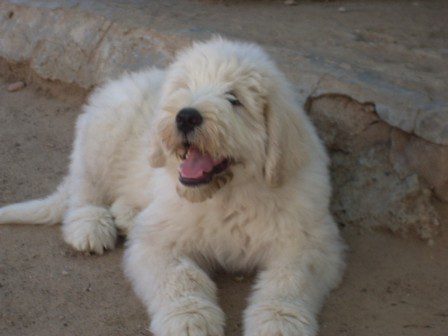
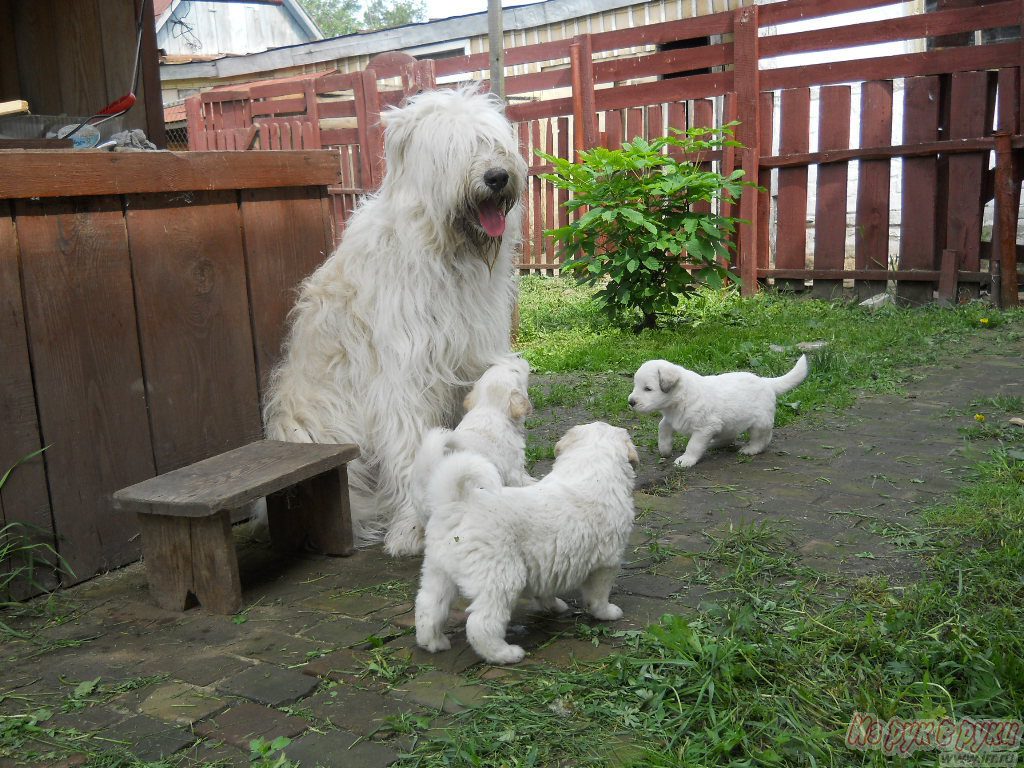
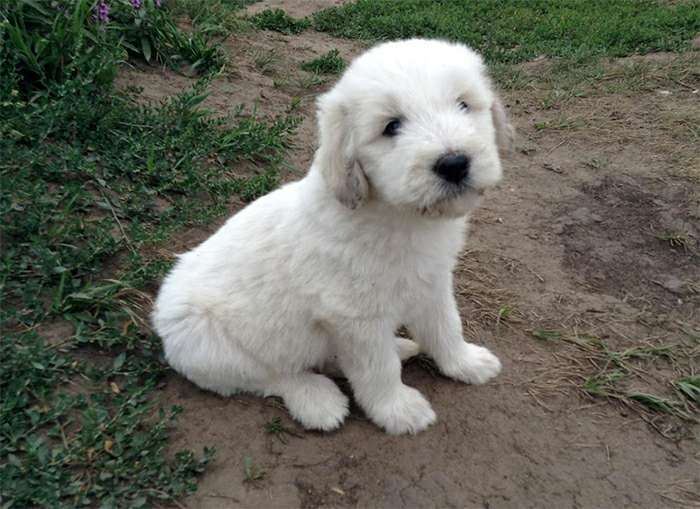


- A healthy Southern puppy is active, curious and brave. The barking of a stranger who has appeared on the territory of the kennel is also a good sign, if it does not turn into a hysterical screech and choking.
- South Russian Shepherd puppies are covered with abundant hair, which makes it difficult to assess their physique, therefore, if you take a dog “with an eye” for a show future, it is better to invite a specialist to evaluate its exterior.
- Choose a breeder who promises to advise on the upbringing and maintenance of the purchased puppy. In addition, responsible cattery owners stipulate the possibility of returning the animal if the buyer has insurmountable difficulties with it. If you are sold YURO without any conditions, there is reason to think about the competence of the breeder.
- If you are not ready to turn into a groomer, endlessly washing the white coat of a pet, buy gray South Russian Shepherd Dogs, which do not have such easily soiled “fur coats”.
- Don’t go for the fattest puppy in the litter, but don’t go for the sluts either. Overfed babies develop worse, and neglected babies will have to be nursed for a long time.
- Be sure to look at the South Russian Shepherd puppy in motion. If the type of gait does not correspond to that described in the standard, then most likely the animal has problems with the joints and distortion of the set of limbs.
South Russian Shepherd Price
If you need a club puppy of a South Russian Shepherd Dog with a metric and a good pedigree, prepare from 500 to 750$. Any “promotions” offering to purchase a representative of the breed for 150-200$ should be immediately dismissed. Maintenance, and even more so breeding of Yuzhaks, is a troublesome and financially costly business, so even the cost of 350$ per puppy is considered unreasonably low. Only unprofessional breeders who sell sick, mentally unhealthy offspring, as well as undocumented mestizo animals, can afford to sell litters at symbolic prices.



